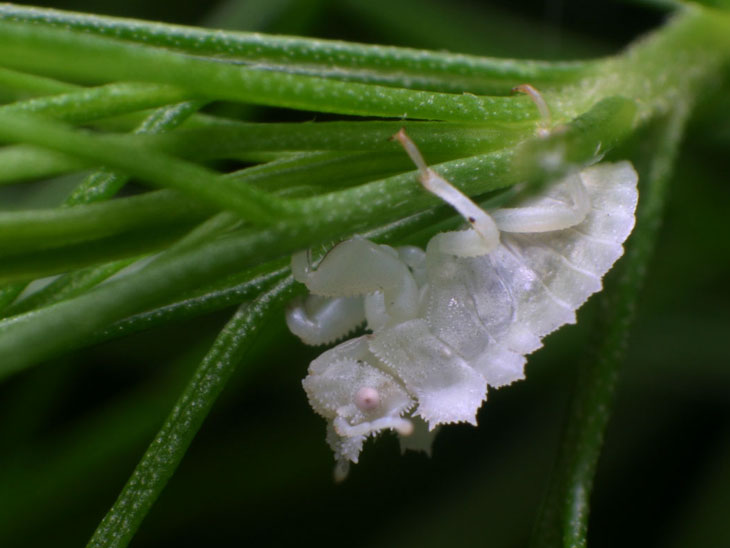
A few days back, I began finding a solitary jagged ambush bug nymph (genus Phymata) on the dog fennel plants. I was pleased, because there’s something about these little predators that’s appealing, and not just to me; The Girlfriend likes them too, solely based on their appearance. I don’t find many of them – my last round of decent photos came two years ago – and a very large adult that I spotted this spring vanished before I could get the lens on it. This one was brilliant white, surprisingly, since they usually rely on camouflage and its chosen eyrie was nothing but rich green threadlike leaves. I’ve had no trouble finding it just about every time I look because of this, despite the fact that it’s less than 5mm in body length.
Earlier this afternoon, I noticed that my friend was sporting some new colors. I’d been pretty certain that there was yellow visible a few days ago, but now a lovely teal hue was also developing on the legs and forebody – still not very effective camouflage, arguably even worse, but rather fetching anyway, so that’s all right.
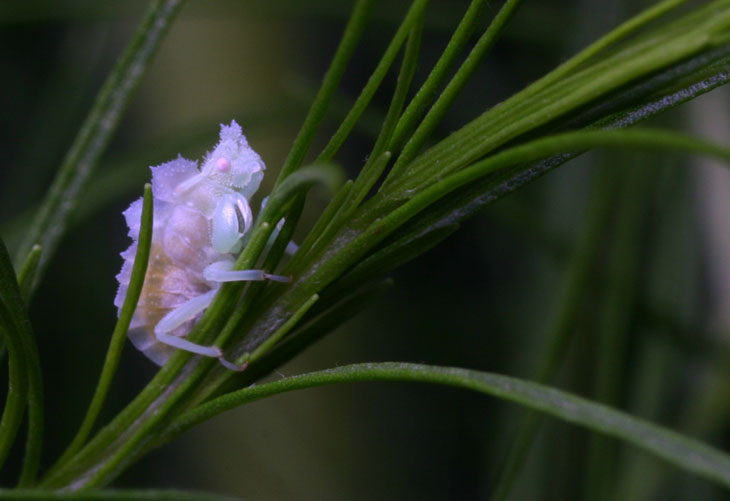
The lack of obscuring color or shape seems not to be hindering it much, however, as I returned later in the evening and found it in possession of a sharpshooter, probably a Graphocephala versuta.
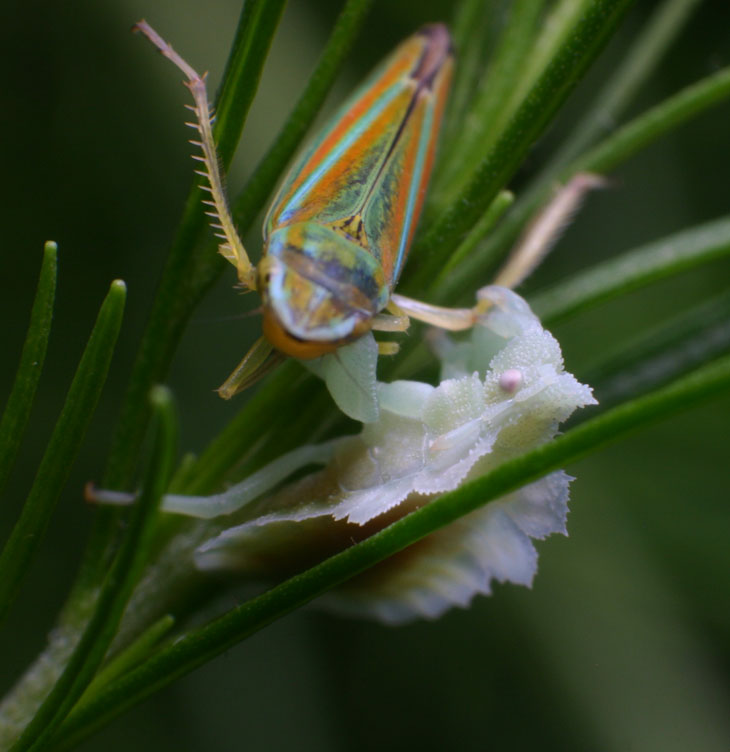
Last year the dog fennel plants had hosted both aphids and lady beetles in vast quantities, but this year the leafhoppers have taken their place (vagaries of season and reproduction I guess,) so the ambush bug has no shortage of available food. And since it hadn’t moved at all from where I’d seen it hours before, it wasn’t like there was a lot of energy expended in obtaining this meal; the sharpshooter had likely just blundered into the Ambush Zone [dramatic music.] Maybe one day I’ll get comfortable and stake out the area to see if I can at least watch a capture, if not get a sequence of images – and I say that knowing that a) I’m liable to need a lot more patience than I actually possess, since I doubt this happens more than once, twice a day, and b) dog fennel plants are not known for their stability, these being three meters tall and waving in the slightest of breezes, which naturally makes macro photography fall somewhere between “demanding” and “fuck this I’m going to become an air traffic controller.” If I were making more money from it I’d probably be a lot more inclined to put in the effort – so if you’d like to see it, get in touch and we’ll talk.
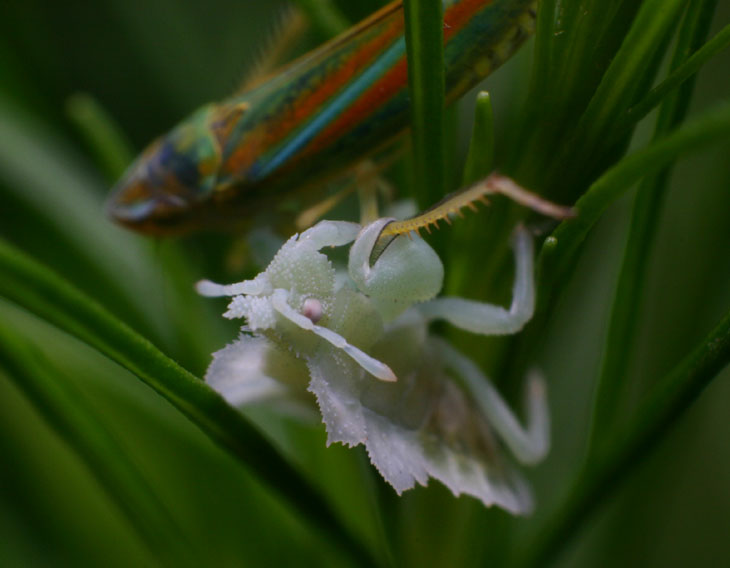
One might be inclined to think that, given the predatory nature and purposeful forelegs, ambush bugs and praying mantids are closely related, but this isn’t the case – they’re actually pretty distant as far as arthropods go, in completely different orders, akin to the difference between humans (order Primates) and otters (order Carnivora,) further separated than humans and lemurs (also Primates.) Ambush bugs are Hemipterans, or ‘True Bugs,’ which means largely that they have sucking mouthparts, and like assassin bugs they drain their prey through their own personal straw, while the mantids crassly and messily dismember their meals like barbarians – but at least they don’t litter the ground with the empties like the Hemipterans. Here’s a nearly full-resolution crop of the same image above, for a better look at the forelegs and proboscis. The black line enhancing the serrations is interesting, but from other images I can say it’s misleading, since these are not sawblades slicing their prey, but merely teeth to maintain a good grip – the contact surface on the distal segment, the one closest to us, is broad like pliers.
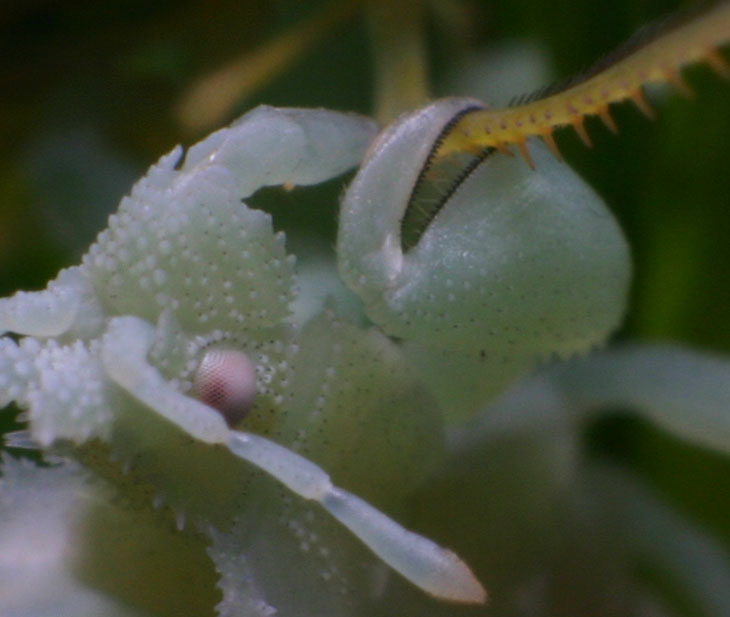
 I close with a scale shot, more or less since I didn’t want to disturb my model – I just grabbed some identical fennel leaves nearby, which is a lot more illustrative than providing the body dimensions. Hopefully you get the idea that it’s easy to blow past one of these unless you’re paying close attention, and of course it’s significantly harder when the camouflage has kicked in. Arthropod photography often requires close examination of likely habitats, but the nice bit is, almost anything is a likely habitat for something, and you can pursue a wide variety of subjects in your own yard. Just be aware that neighbors walking their dog past at night might find the camera strobe going off to be curious, if not outright startling ;-).
I close with a scale shot, more or less since I didn’t want to disturb my model – I just grabbed some identical fennel leaves nearby, which is a lot more illustrative than providing the body dimensions. Hopefully you get the idea that it’s easy to blow past one of these unless you’re paying close attention, and of course it’s significantly harder when the camouflage has kicked in. Arthropod photography often requires close examination of likely habitats, but the nice bit is, almost anything is a likely habitat for something, and you can pursue a wide variety of subjects in your own yard. Just be aware that neighbors walking their dog past at night might find the camera strobe going off to be curious, if not outright startling ;-).




















































